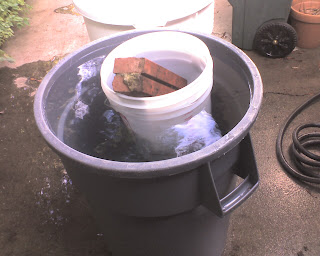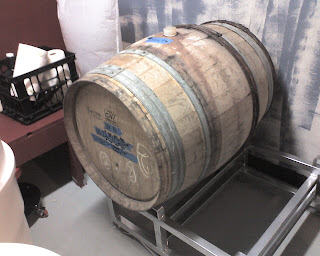Everything used in the winemaking process–testing equipment, barrels, the crusher/destemmer, the press, buckets, and so on–needs to be cleaned and sanitized before and after every use. This requires a lot of water and chemicals.
When we were making wine 6 gallons at a time, it wasn’t such a big deal. But now that we’re making 100+ gallons, the amount of water we use is astounding. The cost of so much water isn’t an issue — water is still unmetered in this part of Sacramento (this will be changing, however). The problem with using so much water is all the waste and the environmental impact.
One change I recently made in our winery is my bucket of rocks ™.
Sometimes, a 44 gallon fermenter needs to be filled with water and cleaning solution and let to stand overnight in order to really get it bacteria and odor-free. The purpose of my bucket of rocks(tm) is to displace a whole bunch of water and allow me to soak the whole inside of the 44 gallon fermenter with significantly less water. Here’s a picture:
 Another thing that just occured to me is that if we switch to using 1-step (no-rinse) sanitizers, we’ll use at least half as much water in cleaning equipment. Is there any reason or application where the use of 1-step would be a bad idea? How does it work, exactly, and why doesn’t it need to be rinsed off?
Another thing that just occured to me is that if we switch to using 1-step (no-rinse) sanitizers, we’ll use at least half as much water in cleaning equipment. Is there any reason or application where the use of 1-step would be a bad idea? How does it work, exactly, and why doesn’t it need to be rinsed off?
Here’s an article from the NY Times that talks, in part, about the environmental impact of a bottle of wine.
I’ve only just started to look into how to make winemaking more environmentally friendly, but there seems to be a lot of information available on the subject. Do you have any ideas or tips from your winery? Post them in the comments.







